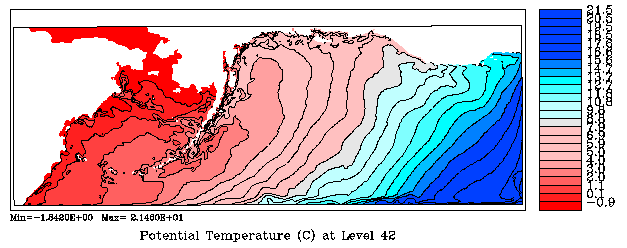Hi
We are using ROMS (v3.0 beta) to model a region of the northeast Atlantic and are having problems at our boundaries. (The shape and location of the model domain can be seen here http://www.marine.ie/home/services/oper ... recast.htm). Specifically, the southern and western boundaries have intense "streaks" in the velocity fields along the boundaries, especially ubar (strongly positive along the southern boundary) and vbar (strongly negative along the western boundary). The "streaks" start to develop within a day of model initialisation but become really noticeable after 15-20 days. The velocities are an order of magnitude higher (1 to 1.5 m/s) than the prescribed velocities at the boundary, but quickly decrease to interior magnitudes (0 to 0.3 m/s) over 5 or 6 grid cells.
The boundary conditions for our model are obtained from the Mercator North Atlantic model and all values are reasonable though there are occasional step-like "corrections" in temperature and salinity. We use TPXO for tidal forcing and use the following cppdef options for all the open boundaries: _M2FLATHER, _FSCHAPMAN, _M3RADIATION, _TRADIATION. We have tried with and without nudging and noticed that the "streaks" are more intense and narrower when nudging is on (tried a few combinations of nudging time-scales).
Has anyone had similar problems? More to the point, has anyone any ideas of how we might fix this?
Spurious currents at open boundaries
Do you have RADIATION_2D? Do you have a sponge (increased horizontal smoothing at the edges)? I see that you (like me) have your grid on a diagonal with respect to the compass directions. My velocities aren't as strong as yours, but your surface temperatures look better. Here's a picture after 58 days:

Have you tried a north-south grid? We both might be better off with such a thing for radiating Rossby waves. In general, our feeling is to keep on going as long as the boundary weirdness doesn't infect the interior solution or cause it to blow up.

Have you tried a north-south grid? We both might be better off with such a thing for radiating Rossby waves. In general, our feeling is to keep on going as long as the boundary weirdness doesn't infect the interior solution or cause it to blow up.
-
klyons
Hi Kate,
Thanks for your reply.
Yes we have tried RADIATION_2D, but we have not tried using the sponge layer. I will implement a sponge and see how that does.
I have to say that we would be loath to change our grid orientation (optimal for our domain, boundaries mostly in deep water, major currents perpendicular to the boundaries).
Thanks for your reply.
Yes we have tried RADIATION_2D, but we have not tried using the sponge layer. I will implement a sponge and see how that does.
I have to say that we would be loath to change our grid orientation (optimal for our domain, boundaries mostly in deep water, major currents perpendicular to the boundaries).